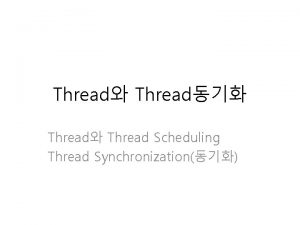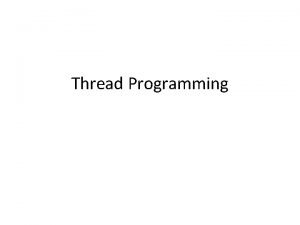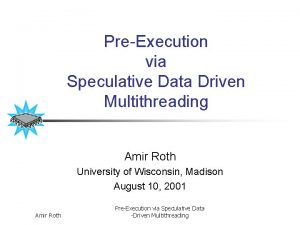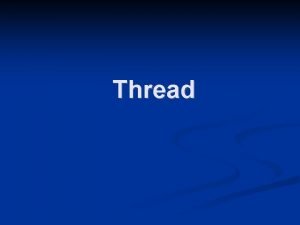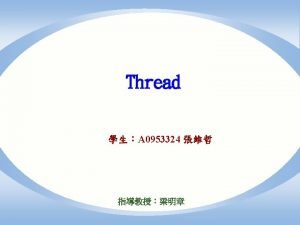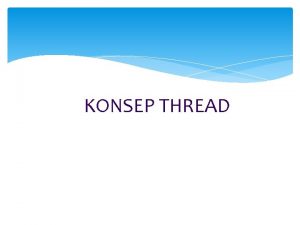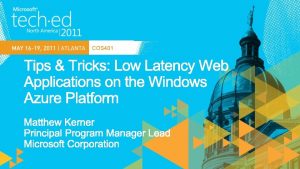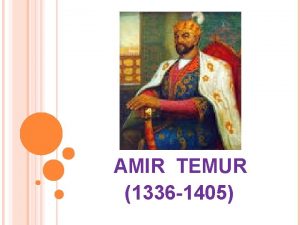A Quantitative Framework for PreExecution Thread Selection Amir




















- Slides: 20

A Quantitative Framework for Pre-Execution Thread Selection Amir Roth University of Pennsylvania Gurindar S. Sohi University of Wisconsin-Madison MICRO-35 Nov. 22, 2002 "Pre-Execution Thread Selection". Amir Roth, MICRO-35

A Quantitative Framework for Pre-Execution Thread Selection Pre-execution: proactive multithreading to tolerate latency • Start with cache miss • Extract computation (dynamic backward slice) • Launch as redundant thread (p-thread) • P-thread = trigger (launch PC) + body (slice) • Effect I: compressed fetch • mt pt P-thread fetchesginitiatesgcompletes miss earlier • Effect II: decoupling • • Miss in p-thread doesn’t stall main thread Sum effect : miss “moved” to p-thread "Pre-Execution Thread Selection". Amir Roth, MICRO-35 2

A Quantitative Framework for Pre-Execution Thread Selection • This paper is not about pre-execution • These papers are • • Assisted Execution [Song+Dubois, USC-TR 98] SSMT [Chappell+, ISCA 99, ISCA 02, MICRO 02] Virtual Function Pre-Computation [Roth+, ICS 99] DDMT [Roth+Sohi, HPCA 01] Speculative Pre-Computation [Collins+, ISCA 01, MICRO 01, PLDI 02] Speculative Slices [Zilles+Sohi, ISCA 01] Software-Controlled Pre-Execution [Luk, ISCA 01] Slice Processors [Moshovos+, ICS 01] "Pre-Execution Thread Selection". Amir Roth, MICRO-35 3

A Quantitative Framework for Pre-Execution Thread Selection P-thread selection: pre-? -execution • What p-threads? When to launch? (same question) • Static p-threads Target static problem loads • Choose <trigger: body> once • Launch many instances • D C • Hard: antagonistic criteria • • • Miss coverage Latency tolerance per instance Overhead per instance Useless instances Longer p-thread = better, worse "Pre-Execution Thread Selection". Amir Roth, MICRO-35 B A 4

A Quantitative Framework for Pre-Execution Thread Selection Quantitative p-thread selection framework • Simultaneously optimizes all four criteria • Accounts for p-thread overlap (later) • Automatic p-thread optimization and merging (paper only) • Abstract pre-execution model (applies to SMT, CMP) • 4 processor parameters • Structured as pre-execution limit study • May be used to study pre-execution potential This paper: static p-threads for L 2 misses "Pre-Execution Thread Selection". Amir Roth, MICRO-35 5

Rest of Talk • Propaganda • Framework proper Master plan • Aggregate advantage • P-thread overlap • • Quick example • Quicker performance evaluation "Pre-Execution Thread Selection". Amir Roth, MICRO-35 6

Plan of Attack and Key Simplifications • Divide • P-threads for one static load at a time • Enumerate all possible* static p-threads Only p-threads sliced directly from program • A priori length restrictions • • Assign benefit estimate to each static p-thread • Number of cycles by which execution time will be reduced • Iterative methods to find set with maximum advantage • Conquer • Merge p-threads with redundant sub-computations "Pre-Execution Thread Selection". Amir Roth, MICRO-35 7

Estimating Static P-thread Goodness Key contribution: simplifications for computational traction 1. One p-thread instance executes at a time (framework) è P-thread interacts with main thread only 2. No natural miss parallelism (framework, not bad for L 2 misses) è P-thread interacts with one main thread miss only 3. Control-less p-threads (by construction) è Dynamic instances are identical 4. No chaining (by construction) è Fixed number of them Strategy • • Model interaction of one dynamic instance with main thread Multiply by (expected) number of dynamic instances "Pre-Execution Thread Selection". Amir Roth, MICRO-35 8

Aggregate Advantage (ADVagg) • ADVagg: static p-thread goodness function Cycles by which static p-thread will accelerate main thread • Combines four criteria into one number • ADVagg = (DCpt-cm * LT) – (DCtrig * OH) • Collect raw materials from traces DCtrig = #instances launched • OH = overhead per (SIZE / BWSEQproc) • DCpt-cm = #misses covered • LT = latency tolerance per (next slide) • "Pre-Execution Thread Selection". Amir Roth, MICRO-35 9

Dynamic P-thread Latency Tolerance (LT) Starting at trigger Lcm Main thread miss execution time (SCDHmt) • Minus p-thread miss execution time (SCDHpt) • Bounded by miss latency (Lcm) • SCDHmt • SCDHpt • LT LT = min(SCDHmt – SCDHpt, Lcm) • SCDH: sequencing constrained dataflow height • Estimate execution time of instruction sequence • For each insn: dataflow + fetch constraint (insn# / BWSEQ) • Computation: explicit • Other main thread work: sparse insn #’s "Pre-Execution Thread Selection". Amir Roth, MICRO-35 10

SCDH and LT Example • Dataflow constraints: Main-thread: miss latency = 8, other latency = 1, serial deps • P-thread: same • • Sequencing constraints: insn# / fetch bandwidth Main thread: sparse / 2 • P-thread: dense / 1 • SCDHmt SCDHpt addi R 5, #16 max(0/2, 0) + 1 = 1 max(0/1, 0) + 1 = 1 lw R 6, 4(R 5) max(7/2, 1) + 1 = 5 max(1/1, 1) + 1 = 2 slli R 7, R 6, #2 max(10/2, 5) + 1 = 6 max(2/1, 2) + 1 = 3 addi R 8, R 7, #rx max(11/2, 6) + 1 = 7 max(3/1, 3) + 1 = 4 lw R 9, 0(R 8) max(12/2, 7) + 8 = 15 max(4/1, 4) + 8 = 12 LT = min(15 – 12, 8) = 3 "Pre-Execution Thread Selection". Amir Roth, MICRO-35 11

ADVagg Example D • Params: 40 misses, 8 cycles each • Max ADVagg = [40*8] – [40*0] = 320 • Impossible to achieve C B • As p-thread length increases… A LT h, DCpt-cm i • OH h, DCtrig o • DCpt-cm * LT = LTagg – DCtrig * OH = OHagg = ADVagg A 40 0 0 80 2/4 40 – 40 B 40 5 200 80 3/4 60 140 C 30 8 240 80 4/4 80 160 D 30 8 240 100 5/4 125 115 "Pre-Execution Thread Selection". Amir Roth, MICRO-35 12

P-thread Overlap • • F: B, C, D have positive ADVagg Q: Why not choose all three? A: They cover same misses (LTagg’s overlap) P-thread overlap: framework… Represents it: slice tree (paper) • Corrects for it: reduces LTagg by shared component • OHagg LTagg B 60 40*5 = 200 C 80 30*8 = 240 LTagg-ovlp LTagg-red ADVagg-red 30*5 = 150 200– 150 = 50 50– 60 200– 60==– 10 140 240– 80 = 160 • Choose overlapping p-threads if ADVagg-red positive • Not in this example "Pre-Execution Thread Selection". Amir Roth, MICRO-35 13

Performance Evaluation • SPEC 2000 benchmarks Alpha EV 6, –O 2 –fast • Complete train input runs, 10% sampling • • Simplescalar-derived simulator Aggressive 6 -wide superscalar • 256 KB 4 -way L 2, 100 cycle memory latency • SMT with 4 threads (p-threads and main thread contend) • • P-threads for L 2 misses • Prefetch into L 2 only "Pre-Execution Thread Selection". Amir Roth, MICRO-35 14

Contribution of Framework Features • Framework accounts for % misses covered (LT) Latency, overhead, overlap • Isolate considerations • • 4 experiments, 3 diagnostics • Measured via p-thread simulation • GREEDY: as much LT as possible % exec increase (OH) % speedup "Pre-Execution Thread Selection". Amir Roth, MICRO-35 15

Contribution of Framework Features • Framework accounts for % misses covered (LT) Latency, overhead, overlap • Isolate considerations • • 4 experiments, 3 diagnostics • Measured via p-thread simulation • GREEDY: as much LT as possible • +LT: as much LT as needed % exec increase (OH) % speedup "Pre-Execution Thread Selection". Amir Roth, MICRO-35 16

Contribution of Framework Features • Framework accounts for % misses covered (LT) Latency, overhead, overlap • Isolate considerations • • 4 experiments, 3 diagnostics • Measured via p-thread simulation • GREEDY: as much LT as possible • +LT: as much LT as needed • +OH: account for overhead % exec increase (OH) % speedup "Pre-Execution Thread Selection". Amir Roth, MICRO-35 17

Contribution of Framework Features • Framework accounts for % misses covered (LT) Latency, overhead, overlap • Isolate considerations • • 4 experiments, 3 diagnostics • • • Measured via p-thread simulation GREEDY: as much LT as possible +LT: as much LT as needed +OH: account for overhead +OVLP: account for overlap % exec increase (OH) % speedup "Pre-Execution Thread Selection". Amir Roth, MICRO-35 18

Pre-Execution Behavior Study • Example: max p-thread length Full framework • 8, 16, 32 • Speedup (%) • Encouraging (intuitive) result • Flexibility increases performance • Also in paper • Merging, optimization, input sets • ADVagg just a model, not completely accurate ADVagg validation: important part of paper • V 1: ADVagg predictions should match simulated diagonostics • V 2: lying to ADVagg should produce worse p-threads • "Pre-Execution Thread Selection". Amir Roth, MICRO-35 19

Summary • P-thread selection • Important and hard • Quantitative static p-thread selection framework Enumerate all possible static p-threads • Assign a benefit value (ADVagg) • Use standard techniques to find maximum benefit set • • Results Accounting for overhead, overlap, optimization helps • Many more results in paper • • Future ADVagg accurate? Simplifications valid? • Non-iterative approximations for real implementations • "Pre-Execution Thread Selection". Amir Roth, MICRO-35 20
 Theoretical framework hypothesis
Theoretical framework hypothesis Scope and limitation sample
Scope and limitation sample Framework of the study example
Framework of the study example Balancing selection vs stabilizing selection
Balancing selection vs stabilizing selection Similarities
Similarities K selected
K selected Natural selection vs artificial selection
Natural selection vs artificial selection Difference between continuous and discontinuous variation
Difference between continuous and discontinuous variation 5 points of natural selection
5 points of natural selection Clumped dispersion
Clumped dispersion Natural selection vs artificial selection
Natural selection vs artificial selection Two way selection and multiway selection
Two way selection and multiway selection Multiway selection
Multiway selection Mass selection and pure line selection
Mass selection and pure line selection Formuö
Formuö Typiska drag för en novell
Typiska drag för en novell Nationell inriktning för artificiell intelligens
Nationell inriktning för artificiell intelligens Ekologiskt fotavtryck
Ekologiskt fotavtryck Varför kallas perioden 1918-1939 för mellankrigstiden?
Varför kallas perioden 1918-1939 för mellankrigstiden? En lathund för arbete med kontinuitetshantering
En lathund för arbete med kontinuitetshantering Särskild löneskatt för pensionskostnader
Särskild löneskatt för pensionskostnader





















